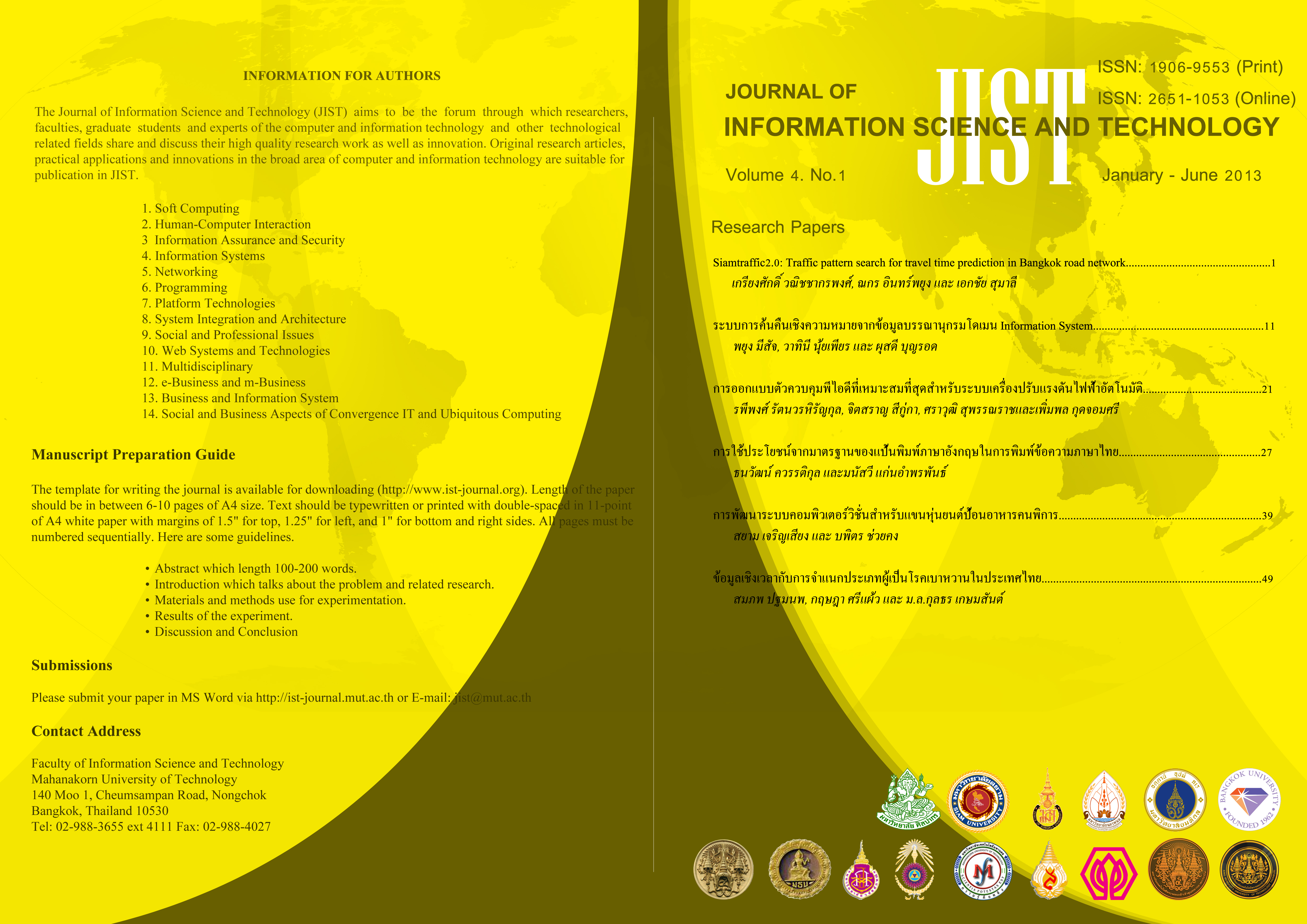Siamtraffic2.0: Traffic pattern search for travel time prediction in Bangkok road network
Main Article Content
Abstract
- This paper presents the travel time prediction system to support the trip planning in Bangkok road network. The system relies on pattern matching taking spatial and temporal traffic speed correlations into account. The road network is divided into traffic link classified independently by type of day for every 5-min time interval. Traffic pattern is then defined by the speed interval. The objective function of the problem is to find the closest match of the traffic pattern in the historical database, in order to estimate the travel time for a specific traffic link. We evaluate the accuracy of forecast by comparing the predicted travel time with the observed data. Four types of the observed links indicate different behaviors of traffic patterns that affect to the applicability of the prediction system. The results have shown that the free-flow traffic link is greater than 85 percent correctly predicted, and the link types of the interrupted traffic flow indicate 60 – 80 percent in the accuracy of forecast. The efficiency of the algorithm in a computational run-time is less than one second per link in 5-min time interval.
Article Details
This work is licensed under a Creative Commons Attribution-NonCommercial-NoDerivatives 4.0 International License.
I/we certify that I/we have participated sufficiently in the intellectual content, conception and design of this work or the analysis and interpretation of the data (when applicable), as well as the writing of the manuscript, to take public responsibility for it and have agreed to have my/our name listed as a contributor. I/we believe the manuscript represents valid work. Neither this manuscript nor one with substantially similar content under my/our authorship has been published or is being considered for publication elsewhere, except as described in the covering letter. I/we certify that all the data collected during the study is presented in this manuscript and no data from the study has been or will be published separately. I/we attest that, if requested by the editors, I/we will provide the data/information or will cooperate fully in obtaining and providing the data/information on which the manuscript is based, for examination by the editors or their assignees. Financial interests, direct or indirect, that exist or may be perceived to exist for individual contributors in connection with the content of this paper have been disclosed in the cover letter. Sources of outside support of the project are named in the cover letter.
I/We hereby transfer(s), assign(s), or otherwise convey(s) all copyright ownership, including any and all rights incidental thereto, exclusively to the Journal, in the event that such work is published by the Journal. The Journal shall own the work, including 1) copyright; 2) the right to grant permission to republish the article in whole or in part, with or without fee; 3) the right to produce preprints or reprints and translate into languages other than English for sale or free distribution; and 4) the right to republish the work in a collection of articles in any other mechanical or electronic format.
We give the rights to the corresponding author to make necessary changes as per the request of the journal, do the rest of the correspondence on our behalf and he/she will act as the guarantor for the manuscript on our behalf.
All persons who have made substantial contributions to the work reported in the manuscript, but who are not contributors, are named in the Acknowledgment and have given me/us their written permission to be named. If I/we do not include an Acknowledgment that means I/we have not received substantial contributions from non-contributors and no contributor has been omitted.
References
2. N.K. Chowdhury, R.P. Nath, H. Lee, and J. Chang, “Development of an effective travel time prediction method using modified moving average approach” in 13th International Conference on Knowledge-Based and Intelligent Information & Engineering Systems, Santiago, Chile, Sep. 2009, pp. 130 – 138.
3. A. Khosravi, E. Mazlouni, S. Nahavandi, D. Creighton, and J.W.C. Lint, “Prediction intervals to account for uncertainties in travel time prediction,” IEEE Trans. Intelligent Transportation Systems, vol. 12, pp. 537 – 547, June 2011.
4. T. Kim, H. Kim, and D.J. Lovell “Traffic flow forecasting: overcoming memory-less property in nearest neighbor non-parametric regression,” in Proceedings of the 8th International Conference on Intelligent Transport Systems, Vienna, Sept. 2005, pp. 965 – 969.
5. W.H.K Lam, K. Chan, M. Tam, and W. Shi, “Short-term travel time forecasts for transport information system in Hong Kong,” Journal of Advanced Transportation, vol. 39, pp. 289-306, Autumn (Fall) 2005.
6. W. Lee, S. Tseng, and S. Tsai, “A knowledge based real-time travel time prediction system for urban network,” Expert Systems with Applications, vol. 36, pp. 4239-4247, April 2009.
7. H.E. Lin, M.A.P Taylor, and R. Zito, “A review of travel time prediction in transport and logistics,” in Proceedings of Eastern Asia Society Transportation Studies. Bangkok, Thailand, Sept. 2005, pp. 1433 – 1448.
8. Y. Liu and Y. Zhang, “Comparison of parametric and non-parametric techniques for non-peak traffic forecasting,” in World Academy of Science and Technology, March 2009, issue 27, pp. 8 – 14.
9. A. Simroth and H. Zahle, “Travel time prediction using floating car data applied to logistics planning,” IEEE Trans. Intelligent Transportation Systems, vol. 12, pp. 243- 253, March 2011.
10. Sumalee, A. (2009) “Incident detection based on short-term travel time forecasting,” Research report: Department of Civil and Structural Engineering, Hong Kong Polytechnic University.


